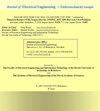Lightweight ultra-wideband antenna array equipped with thin frequency selective surface for high-gain applications
IF 1.2
4区 工程技术
Q4 ENGINEERING, ELECTRICAL & ELECTRONIC
Journal of Electrical Engineering-elektrotechnicky Casopis
Pub Date : 2022-12-01
DOI:10.2478/jee-2022-0054
引用次数: 1
Abstract
Abstract This article begins with an explanation of a frequency selective surface, also known as an FSS, which is used to increase gain across a wide frequency range. The proposed unit design is a modified combination of circular and square elements with two cross dipoles and a T-type structure at the inner side. In the second step of the process, a single wideband antenna that covers the same range as FSS is designed and then analyzed in terms of its gain and radiation patterns. After that, an antenna array was built using the same solo structure in order to take advantage of the benefits that come with using an array system. The array is made up of elements that are CPW fed. A ground-backed T-shaped power divider network with additional shorting pins is used to supply power to the entire array. In the fourth step, an array of the FSS unit cell has been positioned beneath the UWB solo antenna and its array in order to investigate the possibility of improved gain and radiation pattern. The FSS equivalent lumped circuit model is presented here for validation purposes. It has been determined that the results of the experiment and the simulation are consistent with one another. In contrast to the structures that have been reported in the past, the newly developed model possesses a greater bandwidth, a higher gain, and a lower profile.轻型超宽带天线阵列配备薄频率选择表面,适用于高增益应用
摘要本文首先解释了频率选择表面,也称为FSS,用于在宽频率范围内增加增益。所提出的单元设计是圆形和方形单元的改进组合,具有两个交叉偶极子和内侧的T型结构。在该过程的第二步中,设计了覆盖与FSS相同范围的单个宽带天线,然后根据其增益和辐射方向图进行分析。之后,为了利用使用阵列系统带来的好处,使用相同的solo结构构建了天线阵列。该阵列由CPW馈电的元件组成。带有额外短路引脚的接地T形功率分配器网络用于为整个阵列供电。在第四步中,FSS单元的阵列已经被定位在UWB单独天线及其阵列下方,以便研究改进增益和辐射方向图的可能性。本文提出了FSS等效集总电路模型,用于验证。已经确定,实验和模拟的结果是一致的。与过去报道的结构相比,新开发的模型具有更大的带宽、更高的增益和更低的轮廓。
本文章由计算机程序翻译,如有差异,请以英文原文为准。
求助全文
约1分钟内获得全文
求助全文
来源期刊
CiteScore
1.70
自引率
12.50%
发文量
40
审稿时长
6-12 weeks
期刊介绍:
The joint publication of the Slovak University of Technology, Faculty of Electrical Engineering and Information Technology, and of the Slovak Academy of Sciences, Institute of Electrical Engineering, is a wide-scope journal published bimonthly and comprising.
-Automation and Control-
Computer Engineering-
Electronics and Microelectronics-
Electro-physics and Electromagnetism-
Material Science-
Measurement and Metrology-
Power Engineering and Energy Conversion-
Signal Processing and Telecommunications

 求助内容:
求助内容: 应助结果提醒方式:
应助结果提醒方式:


